Amit Spitzer, Cato Networks’ CISO, shares his tried and true methods for succeeding as a CISO, while simultaneously balancing both security needs and business requirements.... Read ›
How to Become a Successful CISO: Advice from Amit Spitzer, Cato Networks’ CISO Amit Spitzer, Cato Networks’ CISO, shares his tried and true methods for succeeding as a CISO, while simultaneously balancing both security needs and business requirements.
After more than 15 years in security and IT, I can honestly recommend the CISO position to security or IT professionals who are looking for a demanding, yet satisfying, position. Whether you’re implementing a new technology that will help mitigate zero-day attacks or consulting the board about the security impact of an M&A, there’s rarely a dull moment in the life of a CISO. In this post, I have put together my top tips for being a successful and effective CISO, based on my own experience. I hope you find it helpful on your own career path. For a tactical and hands-on guide to becoming CISO, take a look at our blog post, “The 5-Step Action Plan to Becoming CISO”.
Before You Begin: Why Do You Want to Become a CISO?
The first step to becoming a CISO is getting clear on why you want to become one. Whether you’re planning to be a CISO at a disruptive technological company or a paper manufacturing facility, the underlying role and responsibilities of the CISO are ultimately the same: protecting the organization from bad actors who are trying to get their hands on sensitive data. If reading this description got your heart beating faster, then security is the right domain for you. Within security, the difference between a C-level security professional (a CISO) and other security professionals is the vision. A CISO envisions how she or he will impact the company’s goals and milestones, contribute to the company’s interests and protect its assets. While this keeps many a CISO up at night, it is also exciting and exhilarating, since you are involved in major company milestones, like IPOs. Are you ready to actively participate in these types of business activities? If the answer is ‘yes’, you’re in the right CISO mindset.
[boxlink link="https://catonetworks.easywebinar.live/registration-94?utm_medium=blog_top_cta&utm_campaign=ciso_perspective_masterclass"] A CISO’s Perspective on Security | Cybersecurity Master Class: Episode 5 [/boxlink]
Starting Your CISO Journey: Taking a Hands-On Approach
In the past, CISOs from legacy enterprises focused on building the organization. This first generation of CISOs was not involved in technologies. Instead, they set the stage for today’s CISOs, who are in the trenches and taking a hands-on technical approach, while also contributing to business-related goals, like their predecessors.
Such deep technological experience is gained by building yourself from the bottom-up. While a CISO is a C-level position, a good CISO will still be passionate about learning and understanding technologies. This means learning all the specifics of threats and risks and how to mitigate them. You know you’ve succeeded when you’re able to swap out all members of your team.
At the same time, a good CISO also needs to be involved in business aspects like growth, revenue, quarterly sales, etc.
Maintaining the Balancing Act Between Security and Functionality
The built-in challenge between Security and Business departments revolves around how to ensure an apt layer of security while maintaining business operational agility. Let’s face it, there is no ideal solution or global truth for answering this challenge. If the pendulum swings too far in one direction, either business or security, the risks will be too high or the business won’t be able to function, and the board might as well close the company.
In the past, the “block everything” approach was commonly implemented by companies. First generation CISOs piled up security solutions that blocked any technology or traffic that could potentially be a risk. But in a fast-growing startup that needs to be agile, this approach could quickly become the kiss of death to the business.
Instead, it is best to understand that there is no security without sales and there are no sales without security. A CISO and the security teams are here to serve the business and be growth enablers. This means understanding that every security decision made can impact the company and its development processes and therefore needs to be taken carefully.
When making decisions, I recommend building a decision tree that displays various routes of decision-making and their business outcome. Let’s think of an extreme example. If a CISO needs to determine whether or not to approve Zoom, some of the negative business outcomes of prohibiting Zoom could be:
Impacting internal communicationHindering communication with external entities: customers, vendors, partners, etc.Spending more IT resources on finding and procuring a different communication solutionTaking up employee resources for implementing and training on the new communication solution
On the other hand, the responsibility for understanding the risks of new technologies and tools is the CISO’s domain. When implementing a solution, don’t settle on visibility through advanced monitoring capabilities. You and your team need to be able to track incidents and mitigate them before they become breaches with a significant blast radius.
Goal-setting, Roadmap Creation and KPI Planning
A CISO’s goals and KPIs are derived from their main mission: protecting the organization from threat actors who are attempting to access the company’s assets. This means different things in different organizations, which makes it hard to create a global benchmark for CISOs.
For example, a KPI in one company could be to reduce the percentage of clicks on phishing emails from 5% to 3%. But in another, phishing emails are not a prominent attack vector, so such a KPI would not be considered a high priority.
I recommend you build and approve your CISO goals, roadmap and KPIs with your leadership team and board. This serves two purposes. First, ensuring that these metrics are aligned with business needs. Second, evangelizing the CISO’s role and responsibilities, and therefore creating a higher chance for you to succeed.
Tips for Getting Hired as a First-time CISO
Finding a first-time CISO role can take some time. Here’s how to make yourself stand out with recruiters and CEOs who are reviewing your CV, comparing you to other applicants or considering you for a first-time role:
Become an expert - Specialize in a security or organizational aspect and make yourself the go-to person for that field. This could be a certain application or how a practice is implemented in an organization. This becomes a strong driver for organizations to hire you and want to include you in their organization.Build confidence in your abilities - Create a sense of trust in your abilities to handle various situations, in your technological capabilities and of your business acumen. By doing so, you will be the person who is handed opportunities when they arise.Combine technology and business capabilities - Build up your business experience by taking a business-oriented approach. Don’t be afraid to hop on customer calls, answer customer questions and participate in cross-departmental brainstorming sessions where commercial questions are discussed. You can also become involved with marketing and sales processes to help them streamline their processes.
Take projects from idea to execution - Find an idea that can help the business and bring it to execution. This includes research, building rapport with colleagues, resource allocation and project management. Comprehensive project management will not only show off your leadership skills, it will also help you hone your combination of technological and business capabilities, to help you build yourself up for the role.
Next Steps for Future CISOs of Tomorrow
Your CISO journey might not be the same as your colleagues’, or it might be a textbook career path from security professional to CISO. Either way, your unique characteristics as a CISO are what will make you stand out, not how you got there. By being enthusiastic about what you do, finding creative ways to solve problems and constantly maintaining an understanding of tech and business growth, you will be able to lead security and make the best decisions for your company, which is the real indicator of success.










